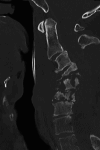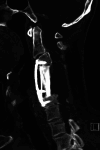Free Vascularized Fibula Graft as Primary Salvage Procedure for Acute Cervical Osteomyelitis Caused by Epidural Abscess
- PMID: 38798940
- PMCID: PMC11124622
- DOI: 10.1097/GOX.0000000000005837
Free Vascularized Fibula Graft as Primary Salvage Procedure for Acute Cervical Osteomyelitis Caused by Epidural Abscess
Abstract
Acute cervical osteomyelitis due to an epidural abscess and pyogenic spondylodiscitis in an immunosuppressed patient with progressive myelopathy is a challenge for the reconstructive surgeon. This report presents our novel approach to treat such a condition in a 56-year-old patient in whom antibiotic treatment and decompression of the medulla by laminectomy of C4-C6 failed. Under general anesthesia, debridement of all infected tissue, including anterior corpectomy of C4-C6, was performed. Simultaneously, a free vascularized fibula graft (FVFG) was harvested, adapted to the bone defect, and anastomosed to the superior thyroid artery and external jugular vein. The graft was stabilized with an anterior plate. A scheduled posterior stabilization was performed 1 week later. Staphylococcus aureus was cultured from bone samples and was treated with antibiotics. The postoperative course was uncomplicated besides a dorsal midline defect 6 weeks postoperatively that was closed with a sensate midline-based perforator flap. Five years on, the patient is infection free, and regular control computed tomography and magnetic resonance imaging scan images show progressive fusion and hypertrophy of the fibula to C3/C7 vertebrae. An FVFG combined with posterior stabilization could be a promising primary salvage procedure in cases with progressive myelopathy caused by acute cervical osteomyelitis due to spinal infection. The FVFG contributes to blood circulation, delivery of antibiotics, and an immunological response to the infected wound bed and can stimulate rapid fusion and hypertrophy over time.
Copyright © 2024 The Authors. Published by Wolters Kluwer Health, Inc. on behalf of The American Society of Plastic Surgeons.
Conflict of interest statement
The authors have no financial interest to declare in relation to the content of this article. This study was supported by a grant from the publication fund of UiT, The Arctic University of Norway.
Figures




Similar articles
-
Pediatric cervical kyphosis in the MRI era (1984-2008) with long-term follow up: literature review.Childs Nerv Syst. 2022 Feb;38(2):361-377. doi: 10.1007/s00381-021-05409-z. Epub 2021 Nov 22. Childs Nerv Syst. 2022. PMID: 34806157 Review.
-
[Two cases of pyogenic cervical discitis presenting tetraparesis].No Shinkei Geka. 2000 Jul;28(7):631-7. No Shinkei Geka. 2000. PMID: 10920825 Japanese.
-
Long segment spinal reconstruction of C3-T1 utilizing single strut fibula free flap following debridement and corpectomy for chronic osteomyelitis.Am J Otolaryngol. 2022 Mar-Apr;43(2):103310. doi: 10.1016/j.amjoto.2021.103310. Epub 2021 Dec 3. Am J Otolaryngol. 2022. PMID: 34894445
-
Results of surgical treatment for degenerative cervical myelopathy: anterior cervical corpectomy and stabilization.Spine (Phila Pa 1976). 2004 Nov 15;29(22):2493-500. doi: 10.1097/01.brs.0000145412.93407.c3. Spine (Phila Pa 1976). 2004. PMID: 15543060
-
Multilevel Corpectomy for Subaxial Cervical Spondylodiscitis: Literature Review and Role of Navigation, Intraoperative Imaging and Augmented Reality.Acta Neurochir Suppl. 2023;135:331-338. doi: 10.1007/978-3-031-36084-8_50. Acta Neurochir Suppl. 2023. PMID: 38153489
References
-
- Ramasastry SS, Schlechter B, Cohen M. Reconstruction of posterior trunk defects. Clin Plast Surg. 1995;22:167–185. - PubMed
-
- Wang AJ, Huang KT, Smith TR, et al. . Cervical spine osteomyelitis: a systematic review of instrumented fusion in the modern era. World Neurosurg. 2018;120:e562–e572. - PubMed
-
- de Weerd L, Solberg TK, Weum S. Closure of complex posterior midline defects after spinal surgery with sensate midline-based perforator flaps and the long-term results. Spine. 2015;40:E1233–E1238. - PubMed
LinkOut - more resources
Full Text Sources
Miscellaneous
